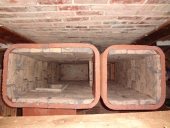I went to the Cold Climate Housing Research Center (
http://www.cchrc.org/masonry-heaters ) yesterday, it is one of the research departments at University of Alaska Fairbanks.
I linked you straight to a picture of the masonry heater they have in their lobby.
It has two dampers on it. The one below and to the right of the firebox has a black handle for the intake air, a tube under the floor leads to outside air.
The other damper handle is brass, up above and still to the right of the firebox, very near where the vertical chimney leaves the masonry mass.
I was talking to one of the engineers, and I asked him, more or less, "So the damper at the top prevents a two way convection current from setting up in the chimney, right? The mass would cool off more quickly if you left the chimney open, right?" And he said, "Exactly."
I am not suggesting all y'all in milder climates need this, let me throw you three things about my local winter.
1. I know the point where the Farenheit temperature and the Celcius temperature is the same number is at -42. I see it on the bank thermometers at stoplights every year, over and over.
2. In January (and December and Febuary and sometimes March) we stop saying "negative" when talking about the weather. When it warms up to "20" we mean the temperature has finally climbed up to -20dF for the first time in a while.
3. My limit to plan to do something outdoors is -30dF. Below that, I basically commute between home, work and the grocery store only. I took the first week of January off in 2013 for an outdoor project, and I took the first week of January off in 2012 for an outdoor project. On the Thursday in 2012 the forecast high was -28dF, but we never saw it; both of those outdoor wintertime projects remain unfinished, because the daytime high temp never exceeded -30dF either year.
Do you need a damper between your thermal mass and the cold outside air? Maybe not. However, if you have a cap of some kind in your woodshed that you can use to cap your chimney on those three or four really cold nights you experience in your local climate (-60dF anyone?), you might notice the difference in how warm your mass is the next morning. -- But you'll have to take your cap off the next morning before you fire your stove.









 1
1























